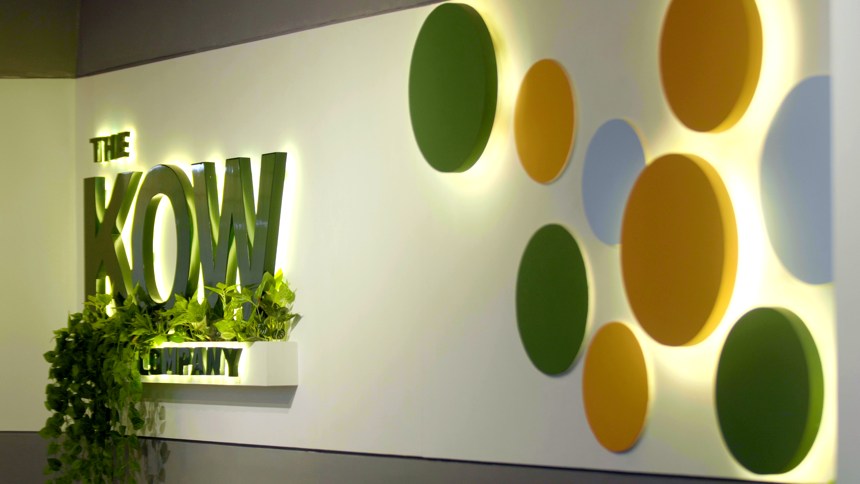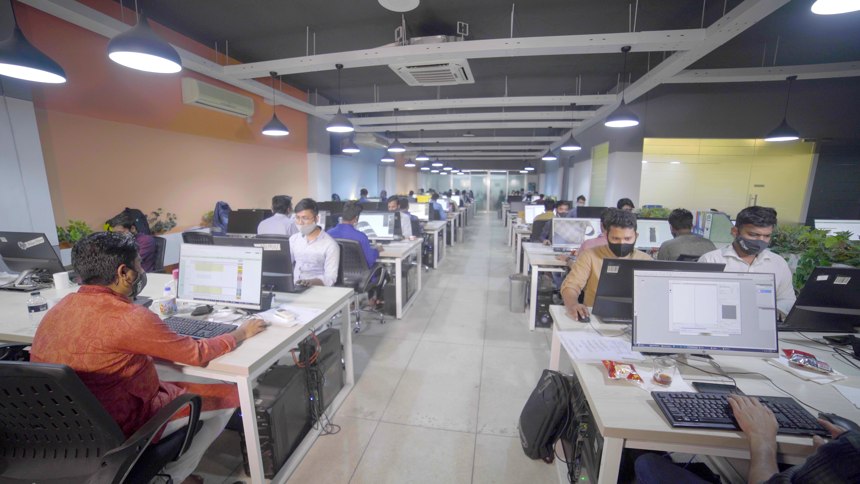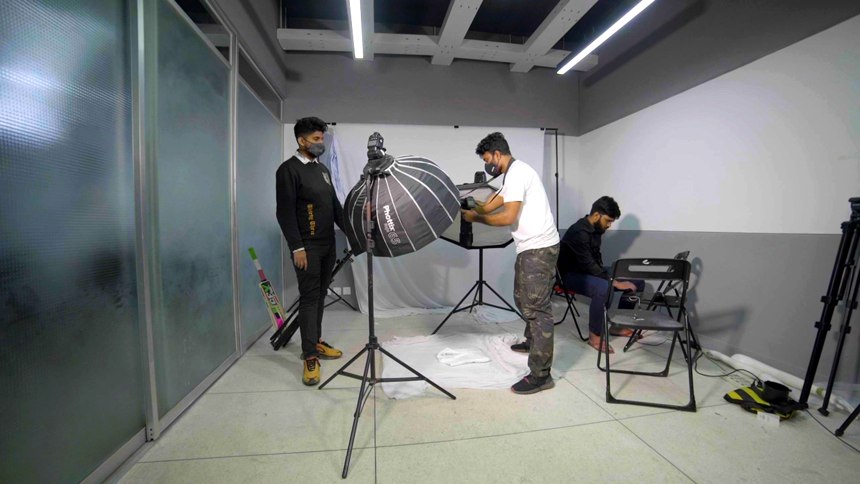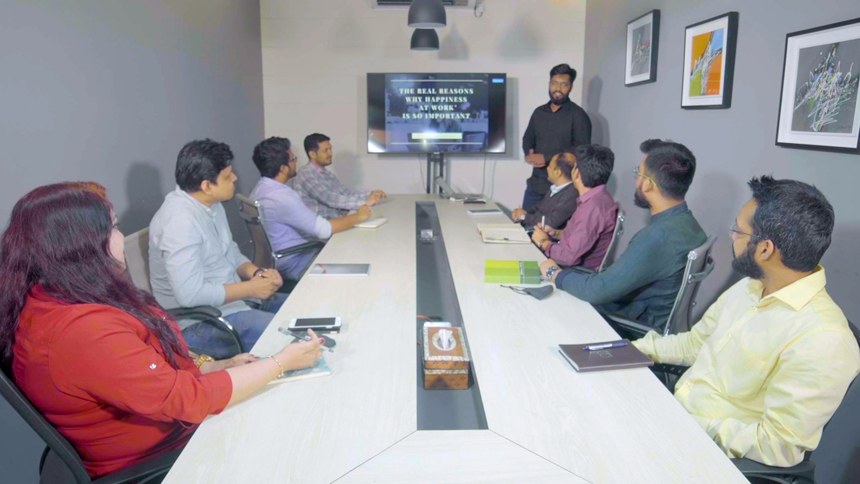
Kowser Ahmed is the Founder and CEO of The KOW Company, a Dhaka-based fast-growing content post-production management company serving global clients.
In this wide-ranging interview, Mr. Ahmed talks about his path to what he is doing today, how he has grown The Kow Company from a small team of 3 people to a leader in image post-production vertical across markets, on company culture, growth, decision making, sales and marketing, jobs of a founder, the state of The KOW Company today and ambition going forward, and much, much more.
Future Startup
Thank you for agreeing to do this interview. To begin with, could you please tell us about your background and your path to what you are doing today?
Kowser Ahmed
In late 2011, I started a garment buying house business. We were doing well. But had to shut down the business for some reasons after a short run. I was jobless for around ten to twelve months. At that time, I knew some buyers with whom I was still in touch online although my business ended. Through my interaction with them, I came to learn about photo editing. I learned about the importance of product photos and how the entire process works.
This is how the concept of a content post-production business first came to my mind, the company name was bVcreatives back then. We took a small office in Bangla Motor. The owner of the space was a Bengali American for whom I worked for four months. We were on good terms. So when I decided to start my business, he wanted to be a part of it. We agreed and started on an equal partnership. We used to start our work in his office in the evening after everyone left, and sleep on the floor at night. He exited the business after a few years. We worked hard during those early days.
In 2017, it came to my mind that we needed an app for small merchants who run businesses through platforms like Shopify and BigCommerce. That’s how our app “CutOutWiz” was born and we launched “CutOutWiz” app on both platforms in early 2018. After much thought, we rebranded the company to ‘The Kow Company Ltd’.
In the beginning, most companies would not reply. In the early months, we would email 500 companies and ten companies would reply, and out of those ten, we would eventually convert 1 or so companies. So around 2-3 companies in every 2000 companies would show interest. It was a tedious job but we were persistent and patient. It eventually paid off.
Future Startup
You started with your laptop, modem, and two designers, what happened after that? How did you find your initial customers?
Kowser Ahmed
The initial customers were my buyers from my failed garment buying house business and other people I knew in the sector. They all eventually became my customers.
Once we exhausted our initial network, we then did some research on e-commerce companies across markets to find potential leads. The process was something like this: we would find the contact person of a company, do a bit of research about him and the company, then send him an email, a reminder, and finally make a phone call.
In the beginning, most companies would not reply. In the early months, we would email 500 companies and ten companies would reply, and out of those ten, we would eventually convert 1 or so companies. So around 2-3 companies in every 2000 companies would show interest. It was a tedious job but we were persistent and patient. It eventually paid off.

Future Startup
How have you attracted customers and grown CutOutWiz? Could you tell us about strategies and activities that you carried out to achieve the growth?
Kowser Ahmed
In business, you only have to be right once. Once you have figured out a successful model, you can see that this is the right way to do things. From there onward, you simply need to repeat it.
I am good at sending out proposals. Whatever you do, if you can find the right person, contact them, convince them to work with you, that’s all about sales. Then you have to have an understanding of how your market works.
We had to bank on so many possibilities to get to where we are now. In 2016, we started doing google advertisements. That time I decided to come out of my shell and make ourselves available to everybody. By that time, we got the BASIS Outsourcing Award. BASIS agreed to work with us along with five other companies.
I started to build a community and network locally. Because of that award program when NTF started on its third phase we were selected for the project. Through the NTF project, we started our journey in the global market, mostly in Canada and Europe.
Today, we have a very different marketing strategy. We do a lot of references. We visit a lot of conferences for customers. I speak in a number of conferences abroad. So right now, instead of attracting customers, we attract interest as well as networking. Our model is actually to build relations. Our target is to become Asia’s most customer-centric editing and content production company. We want to be a super-efficient company. That’s our mission. We are still not there yet, but we surely will be there very soon.
Through networking and relationships, we get the customers. In June last year, in Los Angeles we announced a partnership with one of the largest studio production management software companies called ‘ShotFlow’. Before this when you would shoot in your studio all your images would come to ShotFlow. Then you would have to extract the photos and give them to third-party companies like us. Then companies like us would download and do the editing. Then you would have to give us feedback. Based on your feedback when the images were re-edited you would have to upload the photos on ShotFlow and give approval. Now after the partnership, you don’t have to do anything after studio production shooting. It will directly come to our depository. So you won’t have to do all these processes. This is helping a lot of customers like BestBuy, QVC, Walmart, and other retailers we work with.
Around this time, we thought about building an app that would benefit people in this sector. Suppose you have a Shopify store. Though you are not a big retailer, you are ready to pay $1 for a picture. And Shopify has around 300k merchants. So, we decided to make ourselves visible to them and make the life of all these drop shippers and also small and medium merchandise easier. So we built the app, CutoutWiz. It is in the Shopify app store.
What CutOutWiz does is, if you have a Shopify store you can download our app, and then through the app with the backend of your Shopify admin name you can select all the images, filter through every image, save them, and then you can send the images directly to us. Then we will process all these images and send them back to the app. You’ll get a notification where you’ll be asked to log into your Shopify admin portal, go to our app, and check all the images. If all images are okay, you can select all these images and click replace. You won’t have to download all these images and replace everything in your store. So, it saves your time for copywriters and enables you to go live quickly. We have calculated photo production requires 50-60% of your time. We are giving all this time back to you. While we take care of your images, you can focus on other areas of your business.
We got around 40 original reviews and all of them were positive. We thought of creating a web platform for this so that individual people can also use this and we did it.
Then we thought, why don’t we build an API so that large retail companies with different visual management systems can collect images without a platform and can get the same service. Then why don’t we connect to different APIs to receive and collect images, it will give them flexibility in terms of managing their system.
Managing a third-party company is always a challenge. Now we are the only company from Asia to have an app in the Shopify store, presence in big commerce. We have direct customers as well who can benefit from the whole thing and save thousands of hours. That’s actually where we are right now.

Future Startup
That’s a brilliant story of getting into an untapped market and growing in it.
Kowser Ahmed
I always say that the image editing industry can create thousands of jobs in Bangladesh. We have experience transforming a shopkeeper into an image editor. If you can open a computer, if you can open Photoshop, even if you can’t open the software, we can teach you that.
If we can guarantee volume, like 20 million images a month, we will be able to create jobs for people who are in dire need of opportunity. We have the connectivity now. So if we can build out and set an intra-communication through our server we can operate even from Jessore. We can provide low-cost destinations for large companies like Amazon. If you have to ship a product from China to San Francisco to shoot for Amazon, the expenses are pretty high.
Look at the history of Walmart, they used to produce in Mexico, the US, and Canada. Then all of a sudden they came to Bangladesh, China, Cambodia, and other countries. If you look closely at their journey, you’ll see that they have significantly lowered their prices again and again, but they produce things that people can wear. I am not talking about GUCCI and all these high-end brands. I am talking about people. That’s how Walmart has been able to produce clothing for everybody.
Imagine Walmart is producing only in the US, then an Argentinian who is working at a restaurant or a Mexican guy who is working at a subway station, would not be able to afford that clothing. So in many ways, we see we have a huge opportunity in this space and we could offer better pricing and services to these companies.
In business, you only have to be right once. Once you have figured out a successful model, you can see that this is the right way to do things. From there onward, you simply need to repeat it.
Future Startup
Could you give us an overview of the company at present?
Kowser Ahmed
The company is now called the KOW Company Ltd. We have a number of different brands under one roof such as CutOutWiz, which is our image processing application, KOW Studios, where we have studio networks across work and help brands and companies shoot their product images.
We have our own studio in Dhaka. Globally, we work with about 25 studios. We work with numerous brands through the studio network that we have. We are working with two largest sportswear brands in the world and all the process relating to product image production is done here.
We’ve entered video editing. In 2020, we did some fifty thousand video edits for the international market. We have increased our image processing volume significantly. Today, we process around 25,000 images a day. The number has increased fourfold.
We have grown significantly as a team. We are now a 530-people company.
Future Startup
You have transformed as a company and are now moving up in the value chain.
Kowser Ahmed
If you go back to 1930 or 1950, you will see that international brands used to produce garments in Europe and North-America. With time the production cost has gone up in those places and garments production has shifted to this part of the world. China was once the largest manufacturer. Today, Bangladesh and Vietnam are some of the largest manufacturers. This trend is going to accelerate across verticals in the coming years.
We believe this is going to be the case with photography and videography and image processing in the coming years. Services like product photography would eventually come to countries like Bangladesh, China, etc. just like the garments.
This will happen for a number of reasons. When you produce your garments in Bangladesh and need to ship that to California to do the photographs, you have already lost 14 days in the process. But if you could do the photography where the products are being manufactured, it would save you time and money.
We are digitizing this whole manufacturing process to help brands sell their products online. We’ve figured out that like image processing, photography would come to this part of the world and we want to be the pioneer. Hence we have set up a studio and build a network with other studios around the world. Our ambition is to control the whole value chain of post-production image management and processing.

Future Startup
That’s a huge evolution.
Kowser Ahmed
The thing I ask myself often is why on earth brands should choose my company over other companies. To that end, I have thought about the total workflow or the life-cycle of the service that we offer.
The BPO sector is going through a transformation as artificial intelligence eats into many parts of it. This transformation is only going to accelerate. If a company working with a small part of the BPO sector does not broaden its horizon and take control over the value chain, there is a real chance that it will become irrelevant in the next couple of years as the market transforms.
To address this challenge, we have decided to move up in the value chain and make us an integral part of the entire value chain of image post-production. We have introduced a number of new initiatives, added new services, and introduced improvements into our existing product.
Just about a year ago, we used to take 12-18 hours to process product images and get back to our customers. We have introduced a new workflow where we keep on sending process images to our clients throughout these 12-18 hours. It means we are sending you images every hour and it helps to save many important hours for our clients. We now work in a constant flow.
For example, if a client sends us 400 images, we send the first 100 images after being processed within an hour. Within 12 hours the client receives all the images which save a lot of time. Clients don’t have to wait for a long time. They get a portion of the processed images every hour. Through that, we have improved the efficiency and made the entire thing simpler for our clients.
We have introduced Data reporting using artificial intelligence for our clients that gives an overview of the productive days, when they will get the images and a tentative schedule of the entire process, etc to help our clients schedule their work. One a few companies in the content post-production sector offer this service.
Today, we have a different marketing strategy. We do a lot of references. We visit a lot of conferences for customers. I speak in a number of conferences abroad. So right now, instead of attracting customers, we attract interest as well as networking. Our model is actually to build relations. Our target is to become Asia’s most customer-centric editing and content production company. We want to be a super-efficient company. That’s our mission. We are still not there yet, but we surely will be there soon.
Future Startup
You mentioned you are using AI in your operation.
Kowser Ahmed
We have introduced an automatic productivity analysis tool in the office. Previously, we had an attendance system for our employees. We don’t use that anymore. Instead, when an employee enters the office, the camera records, if they have an ID, they get logged in automatically.
After an employee leaves the office at the end of the day, we get a report immediately through an AI system. The entire attendance and productivity system is managed by our AI tool.
We have put together a system called the Happiness Index, where we try to objectively measure the happiness of our people. The thesis is that people are productive when they are happy and unproductive when they are not.
Every time our camera records you, it analyses your facial expressions, which helps us to know about the mental state of our people. This system has helped our HR department a lot. If our camera records an employee to be unhappy for three consecutive days, the HR department contacts that employee directly to know about the reason why he is not doing or feeling well. As long as our happiness index is 7 out of 10, we are happy.
Back in 2015, our employees needed to write down when they arrived and left the office. We have introduced the new system in 2019. Now employees don’t have to do anything and we can record not only the time of arrival or leaving but also the facial expression of our employees using facial recognition, which is useful to analyze their performance.
The automatic productivity analysis tool along with the happiness index system has helped us to increase our productivity by 11%. Now when I see people are not exactly happy, we play music to cheer people up. This has helped us to understand our people better, make better decisions, and improve company-wide productivity.
On the product side, we’ve added automation where our system can remove image background automatically. We are going to roll it out as a SaaS product within the next six months with this automatic image processing system.
Future Startup
How will SaaS products work?
Kowser Ahmed
We are going to use convolutional neural networks. It will be a B2B product. Users will be able to integrate it with their system, be able to edit product images using the tool. We plan to use a subscription model where you pay us a monthly or yearly subscription to use the tool.
Personally, I believe humans and artificial intelligence should work together. When we use artificial intelligence to process product images, the image editing is usually good upto 95%. But the other 5% is what makes an image great, which cannot be achieved by AI technology. We need human intervention for that.
When our AI system processes an image up to 80% or 95%, the rest is done by our image editors. We put our people and our system together to achieve great results for our customers.
We have put together a system called the Happiness Index, where we try to objectively measure the happiness of our people. The thesis is that people are productive when they are happy and unproductive when they are not.
Future Startup
How has the coronavirus pandemic affected your business? How did you manage your operation when the local came into effect in March 2020?
Kowser Ahmed
The pandemic affected our business. Initially, we saw a small dip but we recovered pretty quickly. We have grown as a company throughout the pandemic. We have added new people to the team. We have hired 70+ people in tech, production, and marketing throughout the pandemic. We renovated our office space and increased our capacity to facilitate people.
On March 26th, we decided to shut the office and go remote as the lockdown came into effect. We faced a number of challenges initially.
We had one PC for every two employees as our employees worked in shifts. We didn’t have enough computers to give out to all of our employees. We bought 100 more computers and gave them out to our employees at the beginning of the lockdown. But that was not enough. We then tagged every 2-3 employees who live alone, asked them to live together and use one computer for office work. That’s how we maximized our productivity. Our employees agreed and eventually found it useful as pandemic made meeting people impossible.
We started to move back to the office from the beginning of January 2021. We have been able to ensure that every one of our people remains healthy and unaffected throughout the pandemic.
We have grown as a business throughout 2020. We have received the National Export Excellence Award in 2020.

Future Startup
How does your marketing and sales work?
Kowser Ahmed
Culturally, we are a flat organization. 30% of our employees are women. We are an equal opportunity company. We treat and pay men and women equally. We encourage women and disable people to come to us so that we can train them.
In 2019, my resolution was to hire two laymen people for every ten expert people, who do not have the slightest idea of image editing. We’ll hire them, train them and pay them during training sessions and after four months when they will finish the training we will employ them as editors. That’s the kind of office culture we look into where you have opportunities to learn and grow.
We are active 24/7. We can’t even recall when was the last time we took a break. Some parts of our office are always operational.
Future Startup
You started as a team of three people and have grown to become one of the leading companies in the space, what worked?
Kowser Ahmed
In terms of growth and attracting sales, my approach is pretty simple as a CEO. You are who you are. The relationship with the customers should be based on three things: facts or reality, proper service, whatever the service you are providing, and be the nicest you can be to your customers. These are what made us successful.
We are a profit-first company. When you come to our office you can see our office culture is pretty flat and here you know what you need to do. We don’t want our people to look for answers when they come to this office in the morning. So we give them the answers beforehand.
Before hiring we tell people to have at least five questions about us otherwise they will not be hired. Then I can put all these questions in a datasheet and later to the dashboard and I can resolve all these things beforehand. So when you join you can see it is made for you which helps our editors to do more. We are like a family.
In terms of growth and attracting sales, my approach is pretty simple as a CEO. You are who you are. The relationship with the customers should be based on three things: facts or reality, proper service, whatever the service you are providing, and be the nicest you can be to your customers. These are what made us successful.
Update 01 on March 8, 3:55 pm: The story has been updated with new information.
